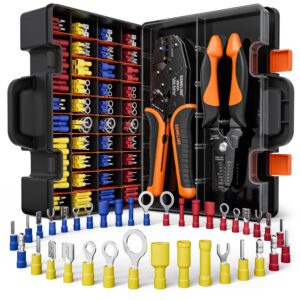
Wire connectors are crucial components in many electrical projects, from simple home repairs to complex installations. Understanding wire can make a big difference in how safely and effectively your electrical system works.
In this guide, we’ll explore everything you need to know about wire. We’ll cover the different types available, how to choose the right one for your project, and some tips for using them properly. Whether you’re a DIY enthusiast or just curious, this post will help you get a clearer picture of wire connectors and their role in electrical work.
What Are Wire Connectors A Simple
Wire connectors are small devices used to join electrical wires together. They help make electrical connections safely and securely. Without these connectors, it would be hard to keep wires in place and ensure that they work properly.
In basic terms, connectors come in various shapes and sizes. Some are designed for specific types of wires or situations. For example, there are connectors for household wiring and others for more complex electrical systems.
The main job of connectors is to prevent electrical faults and ensure a steady flow of electricity. They are important for both new installations and repairs. Understanding wire helps you work on electrical projects safely and efficiently.
Types of Wire Connectors: Which One is Right for You
There are several types of wire connectors, each suited for different needs. Here’s a quick look at the most common types:
- Twist-on Wire Connectors: These are the most common type. They are often used in home wiring and twist onto the wire ends to make a secure connection.
- Push-in Wire Connectors: These are very easy to use. You simply push the wires into the connector, and they stay in place.
- Barrier Strips: These are used for connecting multiple wires at once. They are useful in complex wiring systems.
- Screw Terminals: These connectors use screws to hold wires in place and are often used in heavy-duty applications.
Choosing the right connector depends on what you’re working on. Twist-on connectors are great for home projects, while push-in connectors can save time with simpler tasks.
How to Choose the Best Wire Connectors for Your Project
Selecting the right wire connector is crucial for a successful project. Here’s what to consider:
- Wire Size: Make sure the connector fits the size of your wires. Using the wrong size can cause loose connections or other issues.
- Type of Wiring: Different connectors work best with different types of wiring. For example, twist-on connectors are good for many household applications, while barrier strips are better for complex setups.
- Environment: Consider where the wires will be used. Some connectors are better suited for wet or harsh conditions.
By keeping these factors in mind, you can choose the right wire connectors to ensure a safe and reliable connection.
Step-by-Step Guide: How to Properly Use Wire Connectors
Using wire connectors correctly is important for both safety and performance. Follow these steps to make sure your connections are solid:
- Strip the Wires: Remove the insulation from the ends of the wires. This is usually done with wire strippers.
- Twist or Insert: Depending on the type of connector, either twist the wires together and screw on the connector or push the wires into the connector.
- Check the Connection: Make sure the wires are secure and that there are no loose ends. A proper connection should be firm and stable.
- Insulate if Necessary: Some connections might need additional insulation to ensure safety. This can be done with electrical tape or heat shrink tubing.
Following these steps ensures that your electrical connections are safe and effective.
Common Mistakes to Avoid When Using Connectors
When working with wire connectors, it’s easy to make mistakes. Here’s how to avoid them:
- Using the Wrong Connector: Always choose the right type and size of connector for your project.
- Improper Stripping: Don’t strip too much or too little insulation from the wires. This can affect the connection.
- Over-tightening: If you’re using twist-on connectors, don’t overtighten them. This can damage the wires and create poor connections.
Avoiding these common mistakes will help you achieve better results and make your projects safer.
Wire Connectors vs. Wire Nuts: What’s the Difference
Connectors and wire nuts are often confused, but they serve similar yet distinct purposes. Here’s how they compare:
- Wire Nuts: These are a type of twist-on connector. They twist onto the wire ends and are commonly used in home wiring.
- Wire Connectors: This term can refer to various types, including wire nuts, push-in connectors, and more. They might offer different features and benefits depending on the application.
Understanding these differences helps you choose the best type for your specific needs.
Safety Tips for Working with Wire Connectors
Safety is key when working with electrical components. Here are some important tips:
- Turn Off Power: Always ensure the power is off before working on electrical connections.
- Use Insulated Tools: This helps prevent accidental shocks.
- Double-Check Connections: Make sure all connections are secure and properly insulated before turning the power back on.
Following these tips helps prevent accidents and ensures that your work is safe and reliable.
How to Maintain and Inspect Wire for Longevity
Maintaining wire connectors is important to keep your electrical system running smoothly. Here’s what you should do:
- Regular Inspections: Check connectors periodically for signs of wear or damage.
- Clean Connections: Keep connectors clean and free from dirt or corrosion.
- Replace When Needed: If a connector is damaged or not functioning properly, replace it immediately to avoid issues.
Proper maintenance helps extend the life of your wire and ensures that your electrical system remains in good condition.
Top Tools You Need for Working with Wire Connectors

Having the right tools makes working with wire connectors easier and more effective. Here are some essential tools:
- Wire Strippers: For removing insulation from wires.
- Pliers: Useful for twisting and handling wires.
- Crimping Tool: For certain types of connectors that require crimping.
These tools help you work more efficiently and achieve better results with your wire connectors.
Understanding Wire Ratings and Standards
Wire connectors come with various ratings and standards. Here’s what to know:
- Voltage Rating: This indicates the maximum voltage the connector can handle.
- Temperature Rating: This shows the highest temperature the connector can withstand.
- Certification Standards: Look for connectors that meet industry standards for safety and performance.
Knowing these ratings helps ensure that the wire connectors you use are suitable for your specific needs and conditions.
Conclusion
Wire connectors are small but mighty tools that help us keep electrical systems running smoothly. By choosing the right type and using them correctly, you can make sure your electrical projects are safe and effective. Whether you’re working on a simple home repair or a bigger installation, understanding wire is key.
Always remember to pick the right connector for the job and follow safety tips to avoid mistakes. With the right knowledge and tools, you can handle your electrical tasks confidently and safely. Happy wiring!





